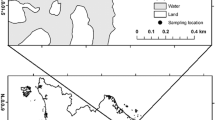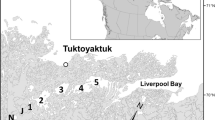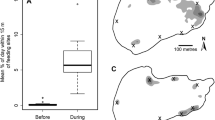Abstract
One goal of research at Little Rock Lake, Wisconsin, is to enhance understanding of lake acidification effects on warm- and cool-water fishery resources. The Little Rock Lake fish assemblage is characteristic of many acid sensitive waters in North America and is dominated by yellow perch (Percidae) and sunfishes (Centrarchidae). Analyses of reproduction, early survival and growth rates in the field were designed around the differing reproductive modes of these taxa. Complementary laboratory research on early life stages was conducted to assist in isolating direct effect mechanisms and to determine the reliability of laboratory results in predicting field response.
Preliminary findings suggest that lake acidification to pH 5.6 has not influenced reproductive activity of the four most: abundant fish species. However, the field results suggest that year-class failure of rock bass (Ambloplites rupestris) may be occurring due to reduced survival of early life stages. Reduced growth and food conversion efficiency of Age 0 largemouth bass (Micropterus salmoides) is also suggested. The laboratory bioassays indicate rock bass is the most acid-sensitive Little Rock Lake species tested. However, rock bass fry survival was not significantly affected until pH was reduced from 5.6 to 5.0.
Similar content being viewed by others
References
Baker JP (1982) Effects on fish of metals associated with acidification. In: Johnson RE (ed) Acid rain/fisheries. Am Fish Soc, Bethesda, Maryland, pp 165–176
Baker JP, Scholfield CL (1982) Aluminum toxicity to fish in acidic water. Water Air Soil Pollut 18:289–309
Benoit DA, Mattson VR, Olson DL (1982) A continuous-flow minidiluter system for toxicity testing. Water Res 16:457–464
Bottrell HH, Duncan A, Gliwicz ZM, Grygierek E, Herzig A, Hillbricht-Ilkowska A, Kurasawa H, Larsson P, Weglenska T (1976) A review of some problems in zooplankton production studies. Norw J Zool 24:419–456
Brezonik PL, Baker LA, Detenbech N, Eaton JG, Frost TM, Kratz TK, Magnuson JJ, McCormick JH, Perry JE, Rose WJ, Shepard BK, Swenson WA, Watras CJ, Webster KE (1986) Experimental acidification of Little Rock Lake, Wisconsin: Baseline studies and predictions of lake responses to acidification. Special Report 7. Water Resource Research Center, University of Minnesota, St. Paul, Minnesota, 43 pp
Forney JL (1977) Reconstruction of yellow perch (Perca flavescens) cohorts from examination of walleye (Stizostedion vitreum) stomachs. J Fish Res Board Can 34:925–932
Harvey HH (1980) Wide spread and diverse changes in the biota of North American lakes and rivers coincident with acidification. In: Drablos D, Tollan A (eds) Ecological Impact of Acid Precipitation. Proc Int Conf, Sandefjord, Norway. SNSF Project, Oslo, Norway, pp 93–97
Hutchinson NJ, Sprague JB (1986) Toxicity of trace metal mixtures to American flagfish (Jordanella floridae) in soft, acidic water and implications for cultural acidification. Can J Fish Aquat Sci 43:647–655
LaZerte BD (1984) Forms of aqueous aluminum in acidified catchments of central Ontario: A methodological analysis. Can J Fish Aquat Sci 41:766–776
Leino RL, McCormick JH, Jensen KM (1987) Changes in the gill histology of fathead minnows and yellow perch transferred to soft water or acidified soft water with particular reference to chloride cells. Cell Tissue Res 250:389–399
Magnuson JJ (1982) Comparative studies of a suite of lakes in Wisconsin. Long-term ecological studies progress report to the National Science Foundation
Magnuson JJ, Baker JP, Rahel F (1984) A critical assessment of the effects of acidification on fisheries. Phil Trans Royal Soc London B305:501–506
McCormick JH, Jensen KM, Leino RL, Stokes GN (1987) Fish blood osmolality, gill histology, and oocyte atresia as early warning acid stress indicators. Annals Soc r zool Belg 117 Supplement 1:309–319
Miller JM (1973) Quantitative push-net system for transect studies of fish and macrozooplankton. Limnol Oceanogr 18:175–178
Mills KM, Chalanchuk SM, Mohr LC, Davies IJ (1987) Response of fish populations in Lake 223 to 8 years of experimental acidification. Can J Fish Aquatic Sci 44 Supplement 1:114–125
Powles PM, Vandeloo DR, Clancy B (1980) Some features of larval rock bass,Ambloplites rupestris (Rafinesque) development in central Ontario. Proc Fourth Annl Larval Fish Conf
Ricker WE (1975) Computation and interpretation of biological statistics of fish populations. Fish Res Board Can Bull 191, 382 pp
Ryan PM, Harvey HH (1977) Growth of rock bass,Ambloplites rupestris, in relation to the morphoedaphic index as an indicator of an environmental stress. J Fish Res Board Can 34:2079–2088
SAS User's Guide (1985) SAS Institute Inc, Cary, North Carolina
Schindler DE (1987) Detecting ecosystem response to anthropogenic stress. Can J Fish Aquat Sci 44 Supplement 1:6–25
Schoener TW (1969) Models of optimal size for solitary predators. Am Nat 103:277–313
Selye H (1956) The stress of life. McGraw Hill, New York, 324 pp
Shuter BJ, McLean JA, Fry EFJ, Regier HA (1980) Sochastic simulation of temperature effects on first-year survival of smallmouth bass. Trans Am Fish Soc 109:1–34
Smock LA (1980) Relationship between body size and biomass of aquatic insects. Freshwater Biol 10:375–383
Swenson WA, Gobin WP, Simonson TD (1988) A calibrated mask-bar for underwater measurement of fish. N Am J Fish Manage 8:(In press)
Watras CJ, Frost TM (1989) Little Rock Lake: Perspectives on an experimental, ecosystem approach to seepage lake acidification. Arch Environ Contam Toxicol 18:157–165
Weiner JG, Eilers JM (1987) Chemical and biological status of lakes and streams in the upper midwest: Assessment of acidic deposition effects. Lakes and Reservoir Manage 3:365–378
Werner EE, Hall DJ (1974) Optimal foraging and the size selection of prey by the bluegill sunfish (Lepomis macrochirus). Ecology 55:1042–1052
Windell JT (1966) Rates of digestion in the bluegill sunfish. Invest Indiana Lakes and Streams 7:185–214
Author information
Authors and Affiliations
Rights and permissions
About this article
Cite this article
Swenson, W.A., McCormick, J.H., Simonson, T.D. et al. Experimental acidification of Little Rock Lake (Wisconsin): Fish research approach and early responses. Arch. Environ. Contam. Toxicol. 18, 167–174 (1989). https://doi.org/10.1007/BF01056201
Received:
Issue Date:
DOI: https://doi.org/10.1007/BF01056201




